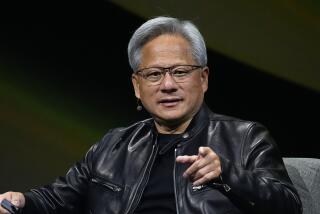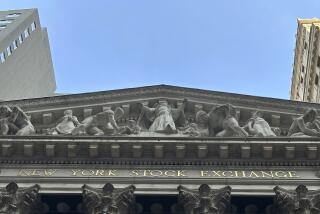Biotech Stocks Hold Long-Term Promise
In a hot stock market, biotechnology is running a fever. The stocks of companies working at the frontier of biology and medicine, such as Amgen and Centocor, have doubled this year and are still rising.
One company working on a vaccine for AIDS, Repligen of Cambridge, Mass., jumped 22% to $29 Tuesday; another, Dr. Jonas Salk’s San Diego-based Immune Response, rose 6% to $50.25.
Faith and hope are behind the action. Investors believe that biotechnology is where the “next Xerox” is to be found, the technological wonder company that will make stockholders rich, as the copier inventor did 30 years ago.
They happen to be right. But picking the right stocks and figuring the true long-term pattern for the biotech industry is no simple matter. The promise is awesome, but the pitfalls are abundant.
The stock market can deceive. In the 1970s, electronics stocks, such as Texas Instruments, National Semiconductor and Intel, rose sharply; in the early ‘80s it was computer stocks such as Apple. Genentech led an earlier advance of biotech issues in the mid-’80s.
Inevitably, prices hit the wall of reality. Brutal competition clipped the semiconductor makers--all but Intel sell well below their historic highs today. The success of IBM’s personal computer temporarily took the glow off Apple, which fell 66% to $5.38 in 1981-’82 and didn’t recover strongly until 1987.
Genentech, lacking the resources to become a global company, sold a controlling interest to Switzerland’s Hoffman-La Roche in 1990--at a price that disappointed shareholder dreams of a big killing.
So history bears out what common sense tells you: Nothing grows to the sky.
But that doesn’t detract from the promise of biotech. If there is one field where long-shot money belongs in these uncertain times, it is biotech. The industry is developing at an incredible pace, with scores of companies working on new compounds for medicine and agriculture. Analyst Denise Gilbert of Smith Barney follows 40 public companies working on 300 compounds, only 18 of which have reached the stage of asking for Food and Drug Administration approval.
Fortunes are made and lost quickly. Earlier this year, Xoma Corp. of Seattle and Centocor Inc. of Philadelphia were in a race for FDA approval of a monoclonal antibody to combat septic shock--the usually fatal spread of poisons released by the body’s bacteria. Centocor won tentative approval, and its stock price has doubled, while Xoma’s stock has fallen 50%. Each company is working on many more products and potential breakthroughs.
But the intensely active corporate scene is only the tip of the iceberg. The potential of scientific research in universities and medical institutes is immense. “In this decade, biotechnology will incorporate the disciplines of computer science, physics, chemistry, applied mathematics; we’ll need all of them,” says Leroy Hood, professor of molecular biology at the California Institute of Technology.
What Hood means is that in genetics, “so much remains to be discovered, and the potential is so great,” says Robert Teitelman, author of “Gene Dreams, Wall Street, Academia and the Rise of Biotechnology.”
Biotechnology has grown out of the Nobel Prize-winning discovery by James Watson and Francis Crick that the form and characteristics of all organisms--animal, vegetable or mineral--are dictated by a genetic code held in a substance called dioxyribonucleic acid, or DNA, in each cell. Having discovered the genetic code, science has been able to work with it, for example to use nature’s own methods for curing disease.
An apt comparison is between chemotherapy, which attacks cancer by introducing powerful chemicals into the body to burn out diseased cells--but has unfortunate side effects because it also hits healthy cells--and bio-engineered products such as Amgen’s granulocyte colony stimulating factor. GCSF stimulates production of white blood cells--the body’s own disease fighters--which can attack cancer with minimal side effects.
Biotechnology also can accentuate resistance to disease in plants--eliminating the need for spraying crops with chemicals. It’s heady stuff.
“It’s the industry that will dwarf all others,” says Hood, who will soon take charge of a new institute of molecular biotechnology at the University of Washington Medical Center in Seattle--adding to the United States’ formidable capabilities in this new science.
“Biotechnology is the key to continued U.S. technological leadership in the world,” says Earle Harbison Jr., president of Monsanto Co., the St. Louis-based chemical giant that has invested almost $2 billion in biotech. Monsanto hopes by the mid-’90s to have genetic products that make cotton naturally resistant to boll weevils and potatoes naturally resistant to blight.
As so often in the past, science fiction is becoming scientific fact. And though the present is a difficult economic time, biotech investors seem eager to buy into a better future.
They’re on the right track.
More to Read
Inside the business of entertainment
The Wide Shot brings you news, analysis and insights on everything from streaming wars to production — and what it all means for the future.
You may occasionally receive promotional content from the Los Angeles Times.










